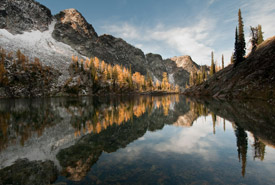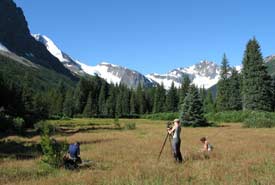The last places on Earth: Protecting globally rare habitats in Canada (Part two)

Alpine Lake on Darkwoods, BC (Photo by Bruce Kirkby)
In part one of our blog on protecting globally rare habitats, Dan Kraus and I explored some of these places found in Canada and how the Nature Conservancy of Canada (NCC) is protecting these important areas. We also identified some of the challenges of identifying rare habitat types and the need for a more comprehensive approach to cataloguing and assessing the conservation status of ecological systems.
A promising approach that is emerging is the IUCN Red List of Ecosystems (RLE). To learn more about this system and how it will inform conservation, I had the privilege of speaking with Rebecca Miller, program manager for IUCN Ecosystem Management:
Josh Noseworthy: Where did the idea for the RLE come from?
Rebecca Miller: The idea has been around for quite a long time. The Red List of Threatened Species is a well-known tool, and it slowly evolved over the past 50 years. As the science of conservation started to take off, we began looking at what was happening around the world at different scales. From this, an idea began to evolve — that we needed to protect the different components of biodiversity, from genes to species to ecosystems. It became apparent that looking only at species wasn’t enough.
We needed a tool that could analyze risks at a higher level than species. Today you hear much more about ecosystems, habitats and landscape-scale conservation as opposed to individual species, and that acknowledges the fact that species depend on the wider environment to survive. This includes other species, but also the non-living environment, such as soil, water and climate, plus the interactions between the living and non-living components. So, people began to realize that in addition to losing individual species, we were losing whole systems ― rivers, lakes, forests, grasslands and the marine environment — and we needed a way to measure this.
JN: What makes the RLE important?
RM: Essentially, it’s important because it allows us to assess the state of the environment at a broad scale. It allows us to look at many species at once, and the way in which they interact with each other. It allows us to look at all the key processes that are essential to maintaining life on Earth, including the ecosystem services that humans depend on as well. So, rather than looking only at species, which are pieces of the puzzle, the RLE gives us a view of the entire puzzle, and helps us assess whether we’re losing critical pieces.
The RLE can also help us make decisions on how we manage the environment, such as through forestry, agriculture and urban development. If you have a map of the world showing the health of its ecosystems, we can begin to find out which areas are under threat, which should be restored and which areas provide essential services to communities. In a nutshell, it allows us to make informed decisions about sustainable development.
JN: Is this the first time we’ve been able to assess ecosystems on a global scale?
RM: Yes! There have been habitat red-listing tools in other places before the IUCN global standard was produced. For example, Norway produced their own habitat red list in 2011, Finland in 2008, and Australia has also been assessing their own ecosystems for quite a long time. However, RLE is the first global standard for assessing ecosystem-level biodiversity.
JN: How do you see the tool being used?
RM: The RLE provides valuable information to decision-makers to help work out the state of the environment they’re working in.
The first thing to do is describe the ecosystem and identify the most important components to maintain. For example, if you have a floodplain forest that depends on certain water levels to keep the forest healthy, then you need to maintain those water levels for the forest to thrive. If you choose to divert that water for something else, then you’ll lose the forest. So, by outlining how the ecosystem works, we get a better understanding of what components we need to protect it to ensure it remains healthy into the future.
Once you have that information, you can classify it based on how healthy it is. For example, it could be of least concern, which means it’s doing OK. It could be near threatened, meaning we need to keep an eye on it. It might also be threatened, endangered or critically endangered, which represent growing levels of alarm. The final category is collapsed ― the ecosystem version of extinction.
RLE is a tool that helps us engage people in responsible land use planning, water use and development, agriculture and other kinds of decisions that often aren’t made with biodiversity in mind.
JN: Do you have a vision for the RLE and how it would be used in the future?
RM: Ultimately, it would be fantastic if every country had an RLE initiative and understood what the risks to their ecosystems were and this informed how to manage them sustainably. We could then paint a picture of what’s happening on a much broader scale. That will take a lot of effort, but it’s certainly doable!
People care about what happens to nature, and I think it’s important that we recognize the importance of the decisions we make and our impact on the environment. We make a lot of good decisions, but we could improve on some of them, so I’d like to see the RLE inform good decisions across the globe.
JN: How can people get involved with the RLE?
RM: There are many ways to get involved. Citizen science is really powerful, and there are many people who are passionate about red-listing and doing assessments on the ecosystems that they know and love. It’s exciting to be part of something that so many people are passionate about.
People can volunteer in other ways too — by helping develop communication materials, writing to politicians to encourage the development of a national red-listing initiative (and Canada has one!), and learn more about the status of ecosystems in your country and what people are doing about it. Make your voice heard, be aware and engage!
The RLE has incredible power to make a difference, and it helps us link up with people who don’t often engage with conservation. I think it has a lot of potential, and I’m looking forward to watching it evolve in the future.
Get more information on the IUCN Red list of ecosystems, and subscribe on Facebook and Twitter for regular updates!
This blog was written collaboratively by NCC's Josh Noseworthy, director of conservation science for NCC's Atlantic Region and Dan Kraus, senior conservation biologist.


